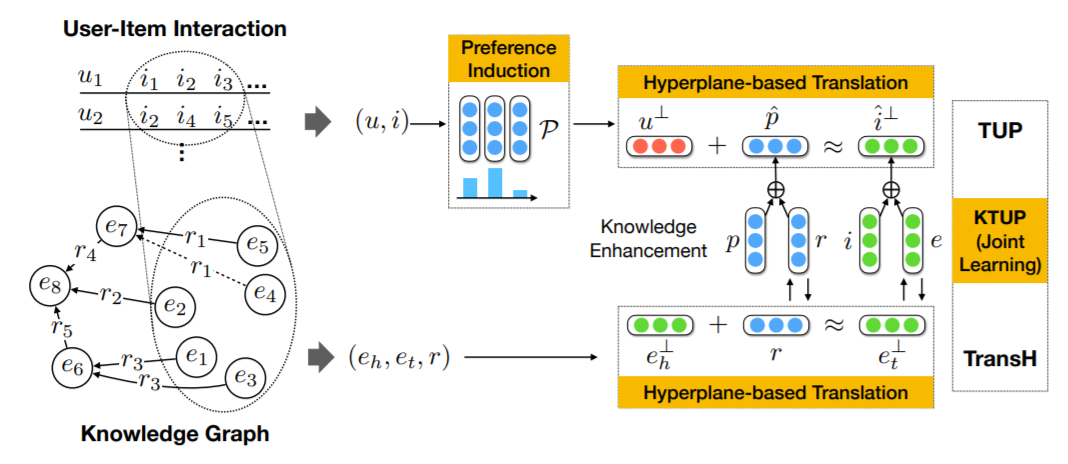KTUP¶
Introduction¶
Title: Unifying Knowledge Graph Learning and Recommendation: Towards a Better Understanding of User Preferences
Authors: Yixin Cao, Xiang Wang, Xiangnan He, Zikun hu, Tat-Seng Chua
Abstract: Incorporating knowledge graph (KG) into recommender system is promising in improving the recommendation accuracy and explainability. However, existing methods largely assume that a KG is complete and simply transfer the “knowledge” in KG at the shallow level of entity raw data or embeddings. This may lead to suboptimal performance, since a practical KG can hardly be complete, and it is common that a KG has missing facts, relations, and entities. Thus, we argue that it is crucial to consider the incomplete nature of KG when incorporating it into recommender system.
In this paper, we jointly learn the model of recommendation and knowledge graph completion. Distinct from previous KG-based recommendation methods, we transfer the relation information in KG, so as to understand the reasons that a user likes an item. As an example, if a user has watched several movies directed by (relation) the same person (entity), we can infer that the director relation plays a critical role when the user makes the decision, thus help to understand the user’s preference at a finer granularity.
Technically, we contribute a new translation-based recommendation model, which specially accounts for various preferences in translating a user to an item, and then jointly train it with a KG completion model by combining several transfer schemes. Extensive experiments on two benchmark datasets show that our method outperforms state-of-the-art KG-based recommendation methods. Further analysis verifies the positive effect of joint training on both tasks of recommendation and KG completion, and the advantage of our model in understanding user preference.

Running with RecBole¶
Model Hyper-Parameters:
train_rec_step (int): The number of steps for continuous training recommendation task. Defaults to5.train_kg_step (int): The number of steps for continuous training knowledge related task. Defaults to5.embedding_size (int): The embedding size of users, items, entities, relations and preferences. Defaults to64.use_st_gumbel (bool): Whether to use gumbel softmax. Defaults toTrue.L1_flag (bool): Whether to use L1 distance to calculate dissimilarity, if set to False, use L2 distance. Defaults toFalse.margin (float): The margin in margin loss. Defaults to1.0.kg_weight (float): The weight decay for kg model. Defaults to1.0.align_weight (float): The align loss weight(make the item embedding in rec and kg more closer). Defaults to1.0.
A Running Example:
Write the following code to a python file, such as run.py
from recbole.quick_start import run_recbole
run_recbole(model='KTUP', dataset='ml-100k')
And then:
python run.py
Tuning Hyper Parameters¶
If you want to use HyperTuning to tune hyper parameters of this model, you can copy the following settings and name it as hyper.test.
learning_rate choice [0.01,0.005,0.001,0.0005,0.0001]
L1_flag choice [True, False]
use_st_gumbel choice [True, False]
train_rec_step choice [8,10]
train_kg_step choice [0,1,2,3,4,5]
Note that we just provide these hyper parameter ranges for reference only, and we can not guarantee that they are the optimal range of this model.
Then, with the source code of RecBole (you can download it from GitHub), you can run the run_hyper.py to tuning:
python run_hyper.py --model=[model_name] --dataset=[dataset_name] --config_files=[config_files_path] --params_file=hyper.test
For more details about Parameter Tuning, refer to Parameter Tuning.
If you want to change parameters, dataset or evaluation settings, take a look at